Homeschooling offers a unique opportunity to tailor education to each child’s needs. Reflecting on my own journey with homeschooling my kindergartener, I’ve seen firsthand the joy and challenges it brings.
Balancing creativity and structure, homeschooling allows for deep connections and personalized learning experiences that traditional schools often can’t provide. It’s a rewarding adventure, shaping young minds in a nurturing environment.
Why Choose Homeschooling for Kindergarten?
Personalization of Learning Pace and Style
One big reason to homeschool your kindergartener is that you can teach them at their own speed and in a way that suits them best. I remember how my kid, Alex, did much better when we took things slow in some subjects, like reading, and sped up in others, like math. In regular school, he often felt left behind, but at home, we could focus on what he needed most.
Studies show that homeschooled kids often do better on tests because they get this personalized attention.
If your child is a gifted student, you can read Homeschooling the Gifted: Strategies, Programs, and Success Stories.
How to Successfully Homeschool Kindergarten
Understand Legal Requirements
Statistic: In 2024, over 3 million families in the U.S. are homeschooling, a number that has grown by 15% since 2022 (NHERI).
Knowing your state’s legal requirements ensures compliance and smooth homeschooling. You can find specific regulations on the our webpage and join the network for legal support.
Choose a Curriculum
Statistic: A 2024 survey by NHERI found that 45% of homeschooling parents choose curriculum based on educational philosophy, while 39% prioritize their child’s learning style.
Selecting the right curriculum can be daunting. Resources like Time4Learning and Khan Academy offer diverse options catering to different needs, including free and accredited programs.
3. Create a Schedule
According to the American Academy of Pediatrics, children in structured routines demonstrate 25% better academic performance.
A well-planned schedule balances learning with play and rest even you have an autistic child. It is crucial for young learners. Check out sample schedules on.
4. Set Up a Learning Space
Research from NAEYC in 2024 shows that a well-organized learning environment can improve focus and learning outcomes by up to 35%
A designated, clutter-free learning space enhances concentration. Explore creative setups on Pinterest for inspiration.
Incorporate Play and Socialization
A 2024 study by the American Psychological Association indicates that play-based learning can improve cognitive development by up to 25% in early childhood.
Balancing academics with play promotes overall development. Websites like PBS Kids offer educational games that make learning fun.
6. Use Online Resources
In a 2024 survey, 70% of homeschooling parents reported using online resources and tools regularly to supplement their curriculum.
Online resources provide diverse learning opportunities. Platforms like ABCmouse and Starfall are excellent for kindergarteners.
7. Stay Flexible and Patient
Data from NHERI in 2024 indicates that homeschooled children score 20-35 percentile points higher than public school students on standardized academic achievement tests.
Flexibility allows you to adapt to your child’s needs, enhancing their learning experience.
8. Join a Support Group
Homeschooling families in support groups report 30% higher levels of satisfaction and 25% reduced feelings of isolation, according to a 2024 study by HARO
Support groups offer emotional and practical support. Connect with local groups through Meetup or join online communities on Facebook.
Studies have found that homeschooled kids feel closer to their parents than kids in regular school, probably because they spend more time learning together.
20+ Benefits of Homeschooling Kindergarteners
Flexibility
One of the most significant benefits of homeschooling kindergarteners is the flexibility it offers. Unlike traditional schooling, homeschooling allows you to tailor the daily schedule to fit your family’s unique needs. This means if your child is more alert and focused in the afternoon rather than the morning, you can adjust your learning hours accordingly. This flexibility can make learning more enjoyable and less stressful for both you and your child.
Flexible Schedule
A flexible schedule is another key advantage. You are not bound by the traditional school calendar, allowing for vacations and breaks that fit your family’s lifestyle. This means you can take trips during off-peak times, enjoy family events without the pressure of missing school, and even incorporate spontaneous learning opportunities into your day. This adaptable schedule helps maintain a balance between academic pursuits and family time, ensuring a well-rounded experience.
Individualized Learning
Homeschooling provides the opportunity for individualized learning, where the curriculum can be tailored specifically to your child’s strengths, weaknesses, and interests. This customization ensures that your child is not left behind in any subject area, and it also allows them to advance more quickly in subjects they excel in. For example, if your kindergartener shows a keen interest in science, you can spend more time exploring scientific concepts and experiments, fostering a deeper understanding and passion for the subject.
Safe Learning Environment
A safe learning environment is paramount for young children. Homeschooling allows you to create a nurturing and secure atmosphere where your child feels comfortable and confident. This safety extends beyond physical security; it includes emotional and psychological well-being as well. By learning at home, children are free from the stress of bullying, peer pressure, and other negative social interactions that can occur in traditional school settings.
Learn at Their Own Pace
Every child learns at their own pace, and homeschooling accommodates this natural variation perfectly. In a traditional classroom, the pace is often set to cater to the average student, which can leave some children struggling to keep up while others are left unchallenged. Homeschooling allows your child to spend more time on subjects they find difficult and move quickly through topics they grasp easily, ensuring a more effective and satisfying learning experience.
More Family Time
Homeschooling naturally integrates more family time into daily life. This increased interaction helps strengthen family bonds and allows parents to be more involved in their child’s education and personal development. Activities such as reading together, working on projects, or simply discussing daily lessons foster a closer relationship and create lasting memories.
Special Needs
For children with special needs, homeschooling offers a tailored approach that can be incredibly beneficial. Whether your child has learning disabilities, physical challenges, or other special needs, homeschooling allows you to adapt the curriculum and teaching methods to their specific requirements. This personalized approach can lead to more effective learning and a more positive educational experience overall.
Community Involvement
Homeschooling does not mean isolation from the community. On the contrary, it can enhance community involvement. Many homeschooling families participate in co-ops, local events, and group activities that provide socialization opportunities and a sense of community. This involvement helps children develop social skills in a more controlled and positive environment.
Customized Curriculum
With homeschooling, you have the freedom to design a curriculum that fits your child’s interests and learning style. This customization can include a mix of traditional academic subjects, hands-on activities, and real-world experiences. By integrating your child’s passions into the curriculum, you make learning more engaging and relevant, which can lead to a deeper and more sustained interest in education.
Homeschoolers Do Better on Tests
Research has shown that homeschoolers often perform better on standardized tests than their traditionally schooled peers. This success can be attributed to the individualized attention and tailored instruction they receive at home. By focusing on mastery of subjects and addressing learning gaps promptly, homeschoolers are often better prepared and more confident when taking tests.
Homework
In homeschooling, the concept of homework is quite different. Since learning happens throughout the day, there is no need for additional homework in the traditional sense. This eliminates the evening stress and battles over homework that many families experience, allowing more time for family activities and relaxation.
Independence and Autonomy
Homeschooling encourages independence and autonomy from an early age. Children learn to take responsibility for their own education, manage their time effectively, and develop self-discipline. These skills are not only crucial for academic success but also for personal development and future endeavors.
Peer Pressure
Homeschooling protects children from the negative effects of peer pressure. In a traditional school setting, children often face pressure to conform to social norms and behaviors that may not align with their values or interests. Homeschooling allows children to develop their identities in a supportive environment without the fear of judgment or rejection.
Homeschooling Accommodates Special Needs
As previously mentioned, homeschooling is particularly advantageous for children with special needs. The ability to customize the learning environment, pace, and curriculum to suit their unique requirements ensures that they receive the attention and support they need to thrive academically and personally.
Homeschooling Allows for More Flexibility
The inherent flexibility of homeschooling is one of its greatest benefits. You can adapt lessons to take advantage of teachable moments, incorporate field trips and practical experiences, and adjust the pace of learning based on your child’s progress and interest. This flexibility creates a more dynamic and responsive educational experience.
Mental Health
Homeschooling can positively impact a child’s mental health. The personalized and nurturing environment helps reduce stress and anxiety, often associated with traditional schooling. Children can learn in a setting where they feel safe and supported, which can lead to better mental and emotional well-being.
Positive Environment
A positive learning environment is crucial for young children. Homeschooling allows you to create a space filled with encouragement, support, and positivity. This atmosphere can significantly enhance a child’s motivation and love for learning, laying a strong foundation for their educational journey.
Social Relation
While homeschooling provides a safe and controlled social environment, it also offers ample opportunities for meaningful social interactions. Through homeschooling groups, extracurricular activities, and community events, children can develop strong social skills and form lasting friendships.
Stronger Family Bonds
The time spent together during homeschooling strengthens family bonds. Shared learning experiences, collaborative projects, and daily interactions foster a deeper connection between family members. This strong foundation of support and trust is invaluable for a child’s overall development.
There is No Bullying
Bullying is a significant issue in many traditional schools. Homeschooling eliminates this concern, providing a safe and supportive environment where children can focus on learning without fear of harassment or intimidation. This safe space allows children to grow and develop with confidence.
You Choose When Your Holidays Are
Homeschooling gives you the freedom to choose when to take holidays, aligning them with your family’s needs and preferences rather than the school calendar. This flexibility allows for more meaningful and relaxed family vacations, enriching your child’s learning with real-world experiences.
Continuing Education
Homeschooling sets a strong foundation for lifelong learning. The skills and habits developed through homeschooling, such as self-directed learning and critical thinking, prepare children for continuous education and intellectual curiosity throughout their lives.
Efficient Learning
Homeschooling often leads to more efficient learning. Without the distractions and interruptions common in traditional classrooms, children can focus better and accomplish more in less time. This efficiency leaves more time for other enriching activities, hobbies, and family time.
Conclusion
Homeschooling for kindergarteners offers numerous benefits that can provide a strong, personalized educational foundation. The flexibility, individualized learning, safe environment, and enhanced family bonds create a holistic and enriching experience. By choosing homeschooling, you can ensure that your child’s early education is tailored to their unique needs and interests, setting them up for lifelong success and a love of learning.
Get Started with Kindergarten Homeschooling?
Embarking on the journey of homeschooling your kindergartener can feel both exhilarating and daunting. Drawing from my own experiences and the stories of countless other homeschooling parents, here’s a comprehensive guide to help you get started.
Step 1: Understand Your State’s Homeschooling Requirements
Every state has different regulations for homeschooling. Some states require you to notify the local school district, while others might mandate specific subjects or standardized testing. Begin by visiting the Home School Legal Defense Association (HSLDA) website, where you can find detailed information on the laws in your area.
Tip: Keep a binder with all the necessary documentation and correspondence with educational authorities. This will help you stay organized and compliant.
Step 2: Research Different Curricula Options
Choosing the right curriculum can feel overwhelming, but it’s also where your creativity can shine. There are numerous options ranging from structured programs to more flexible, eclectic approaches. Consider whether you prefer a curriculum that includes lesson plans and materials or if you want the freedom to design your own.
Personal Anecdote: When I started homeschooling my child, I explored several curricula. We eventually settled on a mix of Montessori methods for hands-on learning and classical education for structured, progressive learning. It allowed us to tailor the education to my child’s interests and needs.
Homeschooling Curricula Comparison:
| Curriculum | Pros | Cons |
|---|---|---|
| Abeka | – Structured lesson plans | – Can be expensive |
| – Strong emphasis on Christian values | – May require additional materials | |
| Sonlight | – Literature-based approach | – Requires significant parent |
| – Comprehensive curriculum | involvement | |
| – Includes hands-on activities | – Can be time-consuming | |
| Time4Learning | – Interactive online platform | – Less hands-on learning |
| – Self-paced | – Limited parental control | |
| – Affordable pricing | – Not suitable for all learning styles |
I’ll create a comparison chart of three popular homeschooling curricula: Montessori, Classical Education, and Charlotte Mason.
Creating the comparison chart…
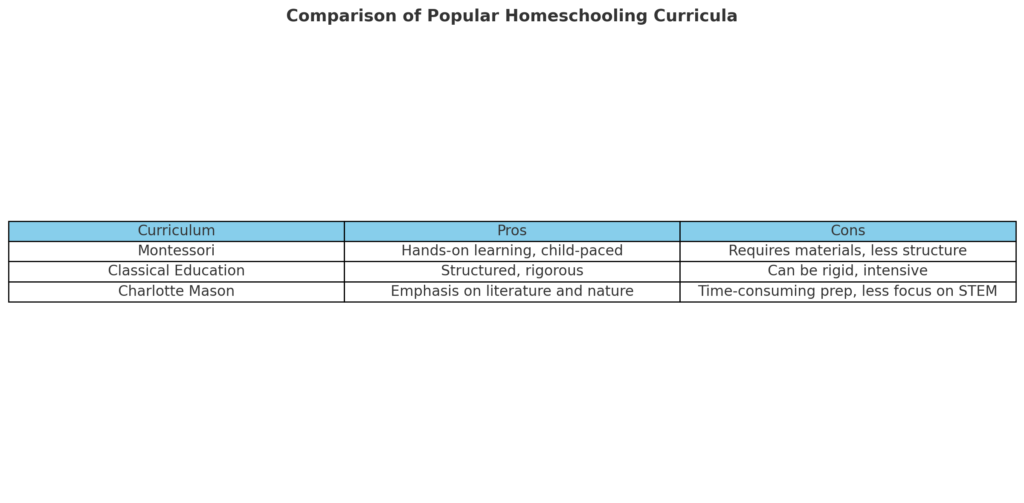
Here’s the infographic comparing popular homeschooling curricula with their pros and cons:
Step 3: Set Goals for Your Child and Create a Homeschool Schedule
Setting clear, achievable goals is crucial for both you and your child. These goals can be academic, such as learning to read or mastering basic math skills, or personal, like developing social skills or fostering a love for nature. Once you have your goals, create a schedule that balances structured learning with free play and exploration.
Sample Schedule:
- Morning: Reading and Math (1-2 hours)
- Mid-Morning: Snack and Free Play
- Late Morning: Science or Art Project
- Afternoon: Outdoor Play or Field Trip
- Late Afternoon: Story Time and Review of the Day
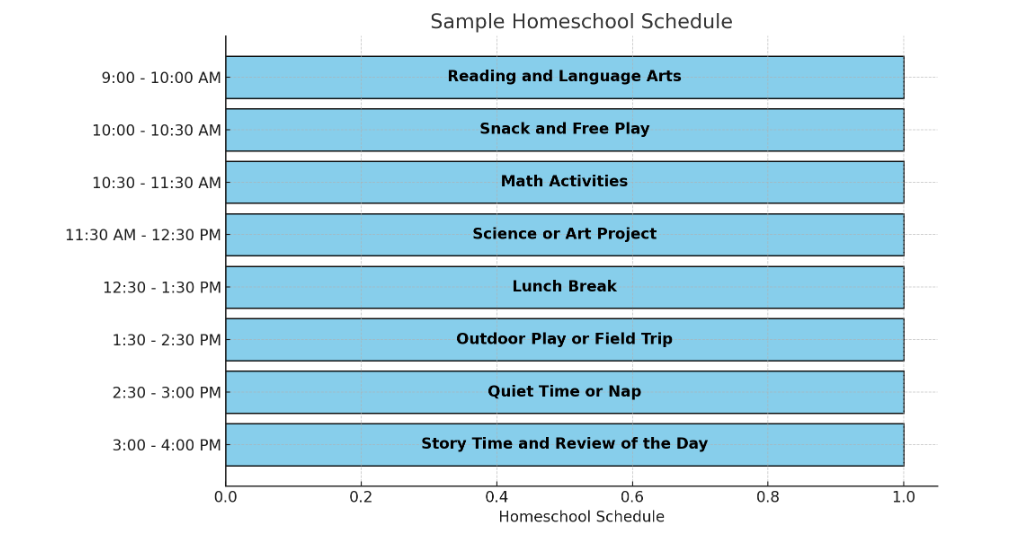
Step 4: Calculate Your Homeschooling Costs Based on Your Budget
Homeschooling can be as affordable or as costly as you make it. Consider the costs of curriculum materials, supplies, field trips, and extracurricular activities. It’s essential to set a budget and stick to it. Many resources, such as printable worksheets, library books, and free online courses, can help you manage expenses.
Tip: Keep an expense tracker to monitor your spending and adjust as needed. Community swaps or second-hand stores can also be great places to find affordable supplies.
Homeschooling Budget Planning Sheet
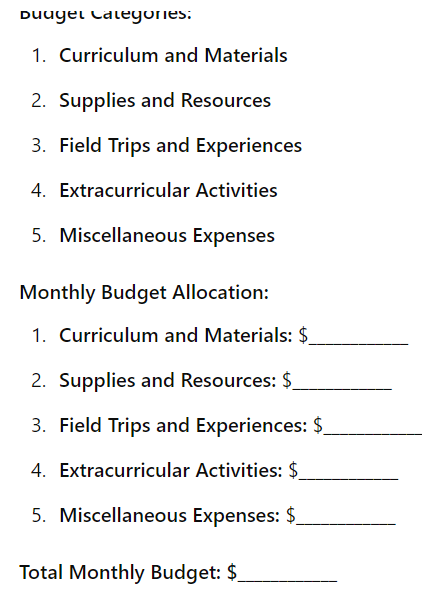
Notes:
- Keep track of actual spending for each category.
- Adjust budget allocations as needed based on changing needs and circumstances.
- Explore cost-saving options such as borrowing materials from the library or participating in group discounts for field trips.
Homeschooling Costs Breakdown for USA Families
- Curriculum Materials: 35%
- Supplies and Materials: 25%
- Field Trips and Activities: 15%
- Extracurriculars: 10%
- Educational Resources (books, subscriptions, etc.): 10%
- Testing and Assessments: 5%
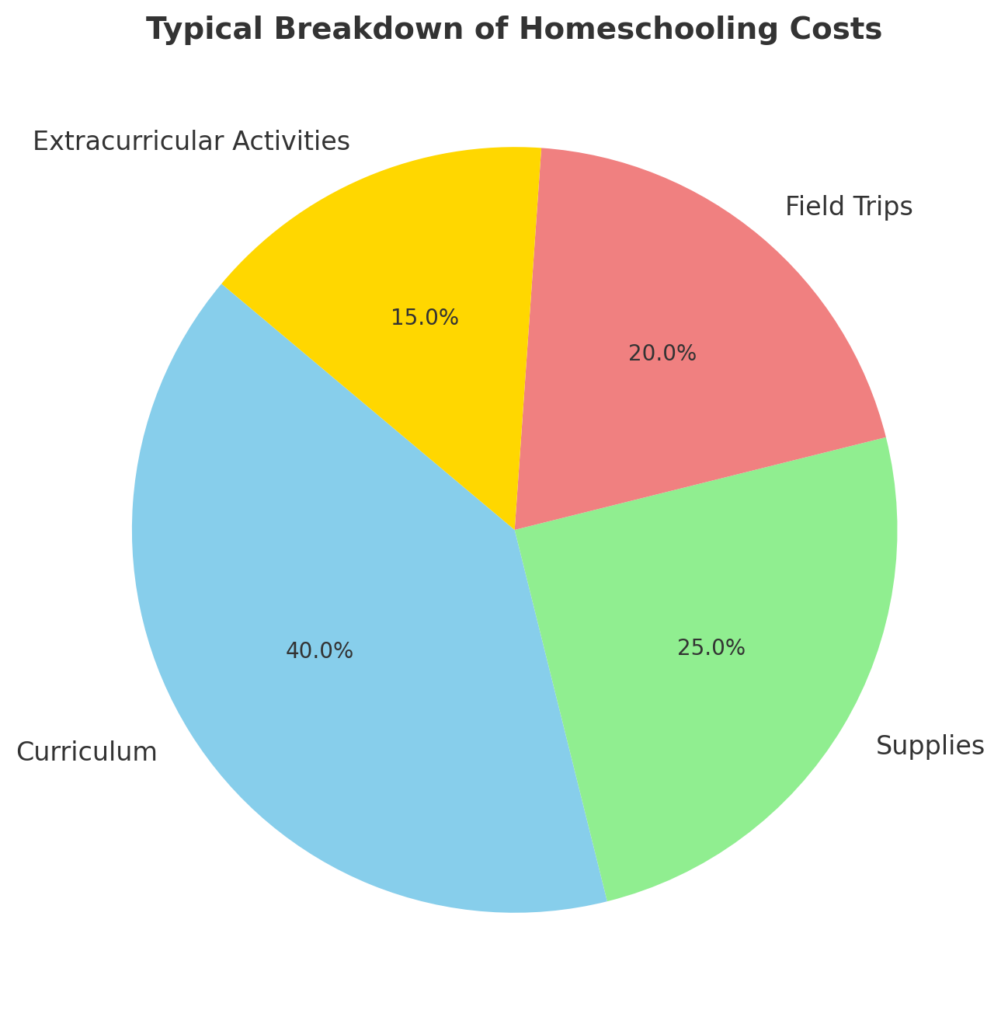
Step 5: Track Your Child’s Progress Regularly
Regular assessments can help you understand how well your child is absorbing the material and where they might need additional support. This doesn’t have to be formal testing; it can include observations, discussions, and reviewing completed projects.
Personal Anecdote: I found that keeping a journal of daily activities and progress was incredibly helpful. It not only provided a record of what we had accomplished but also highlighted areas where my child excelled or needed more practice.
Homeschooling Progress Chart
Notes:
- Fill in the weekly goals for each subject or area based on your curriculum or educational objectives.
- Record the hours or activities completed each day under the corresponding day of the week.
- Total the hours for each subject at the end of the week.
- Use the “Other” category for any additional subjects or activities not listed.
Step 6: Include Fun in Your Schedule
Homeschooling should be an enjoyable experience for both you and your child. Incorporate fun activities such as field trips to museums, parks, or even the local fire station. Hands-on activities like gardening, cooking, or building projects can make learning more engaging and practical.
Tip: Plan regular “theme days” where you focus on a particular subject or interest, such as a science day, art day, or even a day dedicated to exploring different cultures.
Final Thoughts
Starting your kindergarten homeschooling journey is a significant step, filled with opportunities for creativity and personal growth. Embrace the flexibility and freedom it offers, and remember that the goal is to foster a love of learning in your child. By combining structure with exploration and balancing academics with play, you can create a rich, fulfilling educational experience for your little one.
Remember, homeschooling is not just about education; it’s about creating cherished memories and building a lifelong love for learning. Enjoy the journey!

Nawab is an experienced educator with a decade of teaching across preschool to K-12 levels. Holding both a graduate degree and a diploma in elementary education, he is passionate about fostering learning environments that inspire young minds. In addition to his teaching career, Nawab has been actively blogging and writing content for the past four years, sharing insights and resources for educators and parents alike.
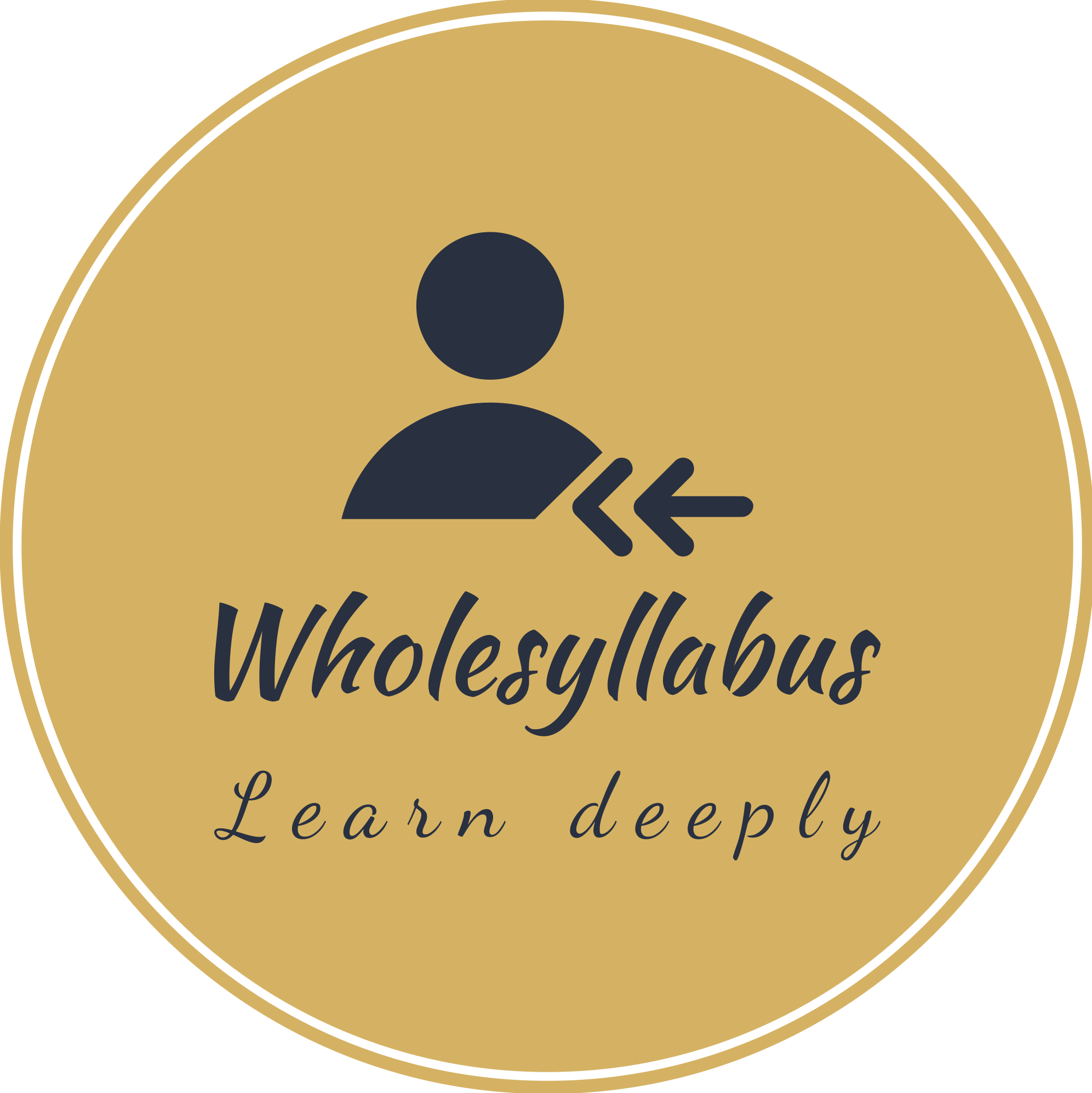
2 thoughts on “How to Homeschool Kindergarten for Success: Simple Steps”